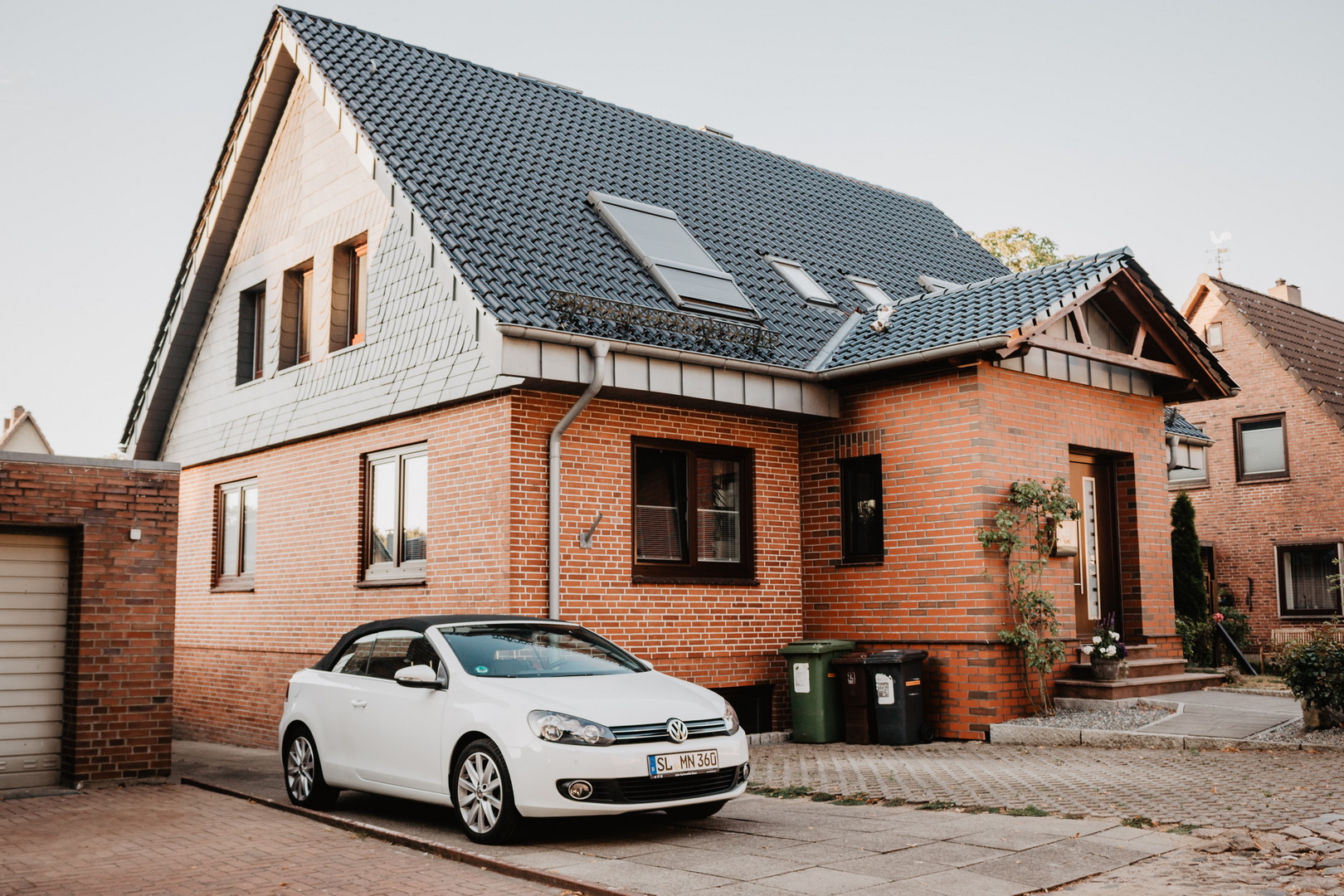
The Real Cost of Roofing in 2025
In 2025, a new asphalt shingle roof costs around $4.50–$6.00 per square foot, while metal roof installation—including standing seam, corrugated steel, or metal shingles—ranges from $9.00–$14.00 per square foot. That means a full residential roofing project can run from $9,000 to $28,000, depending on materials, roof pitch, and design. While shingle roofs are more affordable upfront, metal roofing systems offer better weather resistance, longer lifespan, and potential energy savings.
Metal Roof Vs. Aspahlt Shigles Which is Better?
Choosing a new roof is one of the most significant decisions you’ll make. It is a decision that impacts decades of homeownership. Yet, most people don’t take the time to understand the materials on offer and the best option for their home. For example, do you know what materials are used in metal roofing? Or how well could you explain exactly what asphalt shingle is?
While they both make solid roofing options, each has its specific advantages and drawbacks. You need to understand the balance between cost and longevity, maintenance requirements, and safety, among other features. Below, you’ll get the answers to all these questions, and by the end, you’ll understand which makes the best option for your home – a metal roof or an asphalt shingle roof.
What is Metal Roofing?
Metal roofing can be a broad term as it covers several different materials and styles. Generally, they are manufactured using steel, aluminum, copper, or zinc materials. It has become an incredibly popular roofing material in recent decades and is the second most common roof type in North America. This is down to their often exceptional durability, which can outlast most other roofing materials combined with the ability to withstand variable weather and climates. In the heat, the metal surface even reflects sunlight to reduce cooling costs and energy consumption. Metal roofs also come in different styles, including standing seams and corrugated panels.
What are Asphalt Shingles?
Asphalt shingles are made out of fiberglass or organic materials and then coated with an asphalt mineral granule mixture. Thanks to their affordability and ease of installation, they have become the most popular roofing material in North America. In fact, around 75% of all houses in North America have asphalt shingle roofs. The initial cost of a roof is more affordable compared to other options like metal. On the downside, lifespan is reduced, especially in harsher weather and climates. However, the coating of minerals or ceramics helps protect the tiles from UV light damage and reflect heat. Many residential homeowners love asphalt shingles for the wide variety of colors available to match up with architectural designs. Like metal roofing, there are a few styles of asphalt shingles available, including thinner three-tabs and thicker dimensional shingles.

Cost Analysis
The starting point for choosing between metal roofing and asphalt shingles is pricing. We all have a budget, and let’s be honest, no one enjoys having to fork out for a new roof. But in the long run, getting the investment right is going to make for a happy home rather than frustrating maintenance and leaks to fix every year.
| Roofing Material | Average Cost (Per Sq. Ft.) | Durability | Maintenance | Energy Efficiency |
| Asphalt Shingles | $4 – $7 | 15–25 years | More maintenance | Moderate |
| Architectural Shingles | $5 – $9 | 20–30 years | Moderate | Good |
| Corrugated Metal | $8 – $12 | 40–60 years | Low | High |
| Standing Seam Metal | $12 – $16 | 50–70 years | Very low | Excellent |
| Steel Roof (Galvanized) | $10 – $14 | 40–60 years | Low | Very good |
| Copper Roof | $20 – $30+ | 70–100+ years | Very low | Excellent |
Initial Installation Costs

At the front of your mind is going to be the installation cost. That’s the total you’re going to be paying for your new roof, including materials and completing the re-roofing work.
For a metal roof, it ranges between $7 and $30 per square foot installed. This averages out to around $25,000 per average Canadian home. Although, the total figure can vary greatly depending on home size. Adding to this, higher-end materials like copper and zinc will command premium pricing models.
Comparatively, asphalt shingles are considerably cheaper, ranging between $4 and $7 per square foot installed. This brings the average home installation cost for asphalt to between $7500 and $10,500.
As you can see, asphalt shingles are significantly cheaper, in many cases costing half the price of installation costs. This is a crucial thing to keep in mind. The initial upfront investment is attractive for asphalt, but how does that stack up in the long term?
Long-term Costs and Savings
Here’s the catch when you start looking at the long-term numbers. Yes, metal roofing has a higher initial cost, but it typically lasts 2 to 4 times longer than asphalt. If you’re in your ‘forever home,’ then it might not make sense to go for the cheaper option now only to be left paying more in the decade to come.
Adding to this, in hotter climates, metal roofs can have a significant impact on energy costs as they can reduce cooling costs. Plus, they tend to need fewer repairs and maintenance during their lifespan.
Asphalt roofs can need replacing once or twice in the same lifespan as a metal roof. And their lower resistance to weather conditions can increase insurance premiums in some regions of Canada.
Looking beyond the initial installation, metal roofs often win the battle of cost savings over the long-term homeowners.
Durability and Lifespan
So, we’ve already established that metal roofing tends to be more durable than asphalt shingles. Does that mean that the latter is a bad choice? Well, the answer is no. Otherwise, why would it be so popular?

In fact, asphalt shingle roofs should come with a 15 – 30 year warranty as standard. That’s a confident sign they deliver a decent lifespan for the price. Adding to this, there are more durable options like premium architectural designs, which are tougher than three-tab styles.
Now, if you live in certain climates, then you can run into problems with asphalt shingles. There’s no doubt they are more at risk of damage from high wind and hail than metal alternatives. Adding to this, they can be prone to cracking in extreme temperature fluctuations.
Metal roofs can provide extra peace of mind in areas susceptible to more extreme weather, like high winds and extreme temperature changes. It won’t crack or warm like some other roofing options. Plus, as a non-combustible material, it gives another level of fire protection. It tends to resist moss and fungal growth too! Such is their durability; many manufacturers provide warranties of 50 years to compliment lifespans which can reach 70+ years.
Maintenance Requirements
Metal roofs generally require very little maintenance due to their natural resistance to common roofing issues. Without the need to remove moss and mold growth, cleaning is only occasional. Annual inspections are recommended but less critical than materials like asphalt. Rarely will you need to perform partial replacements, but smaller sections can be repaired. While rare, repairs can be costly and require metal roofing specialists to carry out correctly.
Asphalt roofs will benefit from regular checks to catch any issues early such as curling, cracking, or missing shingles. Adding to this, they are more susceptible to moss and fungal growth, so more regular cleaning is a good idea to retain lifespan. Happily, they are easier and cheaper to repair any damage; tile replacements might be required after storms and high winds, but this is a reasonably straightforward job.
Eavestrough repair and cleaning will be required for both roof types, although it might be more regular with asphalt options as minerals and debris collect from the roof in the guttering.

Weight Considerations
Metal roofing is a lighter option than asphalt shingles, weighing in at between 1 and 3 pounds per square foot. It is so light that it can even be installed on existing roofs in certain circumstances. It is a trick used to save on removal costs. The weight profile helps to reduce structural strain on buildings; this might be useful for older homes with structural concerns. In addition, the reduced mass performed better in defending against earthquakes. For expansive structures, like commercial roofs, can be installed without additional support.
Asphalt shingles are a little heavier, between 2 and 4 pounds per square foot, and this weight can increase a little when wet. The extra weight isn’t a problem on newer homes, and it is often the material of choice for housing developers and new builds. However, its use should be evaluated on more expansive buildings when additional support is limited.
Environmental and Energy Efficiency
Asphalt shingle absorbs heat rather than reflect it. This is a key point to consider, depending on your local climate. For example, in hotter areas, this is probably bad news as it puts more strain on cooling systems. It can actually increase indoor temperatures by several degrees. Of course, if you live in a colder climate, for example, you’re installing a roof in Niagara, then this is a welcome addition, helping to retain indoor heat and reduce heating costs. There are no new ‘cool roof’ asphalt options available to reflect sunlight. However, this is still less effective than the reflective benefits of metallic roofing materials, which can reduce cooling costs by 10% – 25% in summer months.
So what about the environmental footprint of metal roofs vs asphalt shingles? Well, the first can be made of recycled materials. Depending on the supplier, the metal can contain upto 95% recycled material. And it is recyclable at the end of its lifespan. Asphalt shingle is petroleum-based with a higher carbon footprint. This is compounded by limited recyclability, meaning the roofs can end up in landfills after use.
Aesthetic and Curb Appeal
Asphalt shingles boast the traditional appearance that modern homeowners and neighborhoods prefer. The wide variety of color and texture options allows new builds to have their own personality. For housing developments, a clean, uniform design and color palette can be achieved at an efficient cost. Plus, repairs can be made to match current designs with minimal problems. It is considered a safe, conventional look that blends in and is unlikely to disrupt the future sale of a property.
Metal roofing can be more distinctive in style and even set homes apart. Of course, this depends on the style, color, and finish applied. Premium option scan even mimics other roofing materials with wood or slate style finishes to blend in with other properties. You might be surprised at the intricate clay tiling effect that can be achieved on modern metal roofs.
Fire Resistance and Safety
Most asphalt shingles have a Class A fire safety rating when correctly installed. This means they are generally fire retardant with a flame spread rating below 25. In simple terms, they are effective against severe fire exposure, although they can burn under severe combustion heat.
Metal roofing also has the highest Class A fire rating. It is naturally a non-combustible material that won’t ignite in severe building fires. In fact, it can help prevent fire from spreading to neighboring buildings. Its high rating can be a comfort in higher-risk areas and a potential reduction in homeowner insurance premiums.
Ease of Installation and Replacement
It is often easier to find asphalt shingle roofing installers. The process is easier and faster than metal roofing. Most contractors have the necessary tools and skills to carry out the work. A large part of the reduced installation cost is the reduced labor required to complete the job. Adding to this, homeowners are more DIY-friendly for minor repairs and replacements. The simple fact is that they are more straightforward to install.
Metal roofs, on the other hand, require specialized tooling and skills to install. There are usually fewer roofing contractors to choose from who have a successful track record for metal roofs. The installation process is longer, so proper installation is critical to performance and warranty. The flashing and edge detailing are more complex and need to be paired with innovative underlay systems. This means selecting an experienced roofing contractor is even more critical.
Conclusion: Metal Roofs vs Asphalt Shingle Roofs

As you can see, there’s a balance to strike when choosing a new roof. The material you select will affect so many different factors, from longevity to overall cost to maintenance requirements.
Metal roofs are the premium option, which boasts superior durability and minimal maintenance requirements. You won’t need to worry about moss and algae growth or that tiles might go missing during a storm. In the summer months, heat is reflected back into the atmosphere to help reduce energy costs. Although, this could be frustrating during cold winters. The lifespan of 50+ years does come with an initial installation cost, which can outstrip other materials by several multiples. But it is unlikely you’ll need to replace it for a very long time. Adding to this, more complex installation processes require more skilled contractors to complete the jobs and perform future repairs.
Asphalt shingles go head to head with metal roofing and can come up short in long-term performance. It is generally not going to last as long, but this might not be a worry for you if you’re planning to move homes over the next decade. While durability suffers, asphalt is hands down the most popular roofing material in North America. The lower installation cost combined with the traditional aesthetic is a big draw for homeowners. Just be aware that you’ll need to give a regular checkup and keep it in a good state of repair – repairs that will be cheaper and easier than metal roofs, to be fair.
Frequently Asked Questions
Which is better metal roofing or shingles?
Metal roofs offer a longer lifespan and energy efficiency than asphalt shingles, but the latter is more popular thanks to reduced installation costs and simple repairs.
What are the disadvantages of a metal roof?
Metal roofs can be expensive to install, even 50%+ more than asphalt alternatives. Finding a reliable contractor can be tricky, too, with the installation process requiring more skill and specialist tooling. During heavy rain, it can be noisy, especially when improperly installed.
What is the biggest problem with metal roofs?
Initial installation costs are the most significant barrier for homeowners, and the installation quality can greatly affect the performance and appearance. Finding quality installers can also be challenging in some areas, while future repair can be expensive when damage occurs.
What happens if lightning strikes a metal roof?
Metal roofs do not attract lightning any more than other roofing materials. When struck, the metal just disperses the electrical energy throughout the structure. Plus, the non-combustible characteristics of metal mean ignition from lightning isn’t a problem.
How long does a metal roof last compared to shingles?
Metal roofs usually last 50 – 70 years and can even come with 50-year warranties. Premium options like copper and zinc can even last over 100 years. Asphalt shingles often last around 30+ years, but they can degrade more quickly than metal, particularly in harsh weather and climates.
Is metal cheaper than asphalt roofing
No metal roofs are usually more expensive than asphalt roofing. This is because materials and installation labor cost more than asphalt, which is quicker and easier to install and repair.























